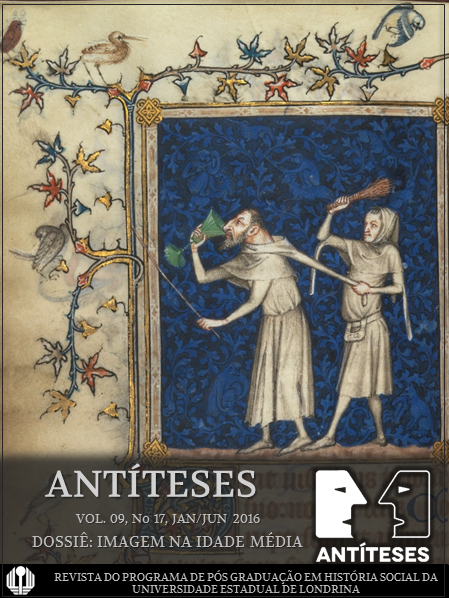Battles of Uccello: the look of time and history
DOI:
https://doi.org/10.5433/1984-3356.2016v9n17p55Keywords:
Uccello, Saint Roman, Médicis, Florence, QuatrocentoAbstract
Since the 12th century, the commercial growth, increasingly important in the Italian cities, favored the ascension of a powerful social group. This group’s wealth also was based in the financial capital. During the next centuries, Florence became an important urban center with the population growth. The political domain belonged to the important families in which the Médicis are distinguished, whose patronage ensured the artistic and cultural developing in the city. Such circumstances allowed an artistic movement without precedents and made Florence a point of convergences for painters, sculptures and architects. The art, before confined in churches, conquered the public and private spaces as the important families’ sumptuous palaces. In this context, this research aims to study the Saint Roman Battle, triptych painted by Paolo di Dono, ditto Ucello. After a succession of owners, hard to be determined, the panels ended being part of Lorenzo Médicis’ patrimony. Nowadays, the triptych is dismembered and it’s found in three different museums in Europe. It’s searched to investigate the artistic and cultural content in these panels and to follow the History as well as the different spectator’s perspectives about it.Downloads
Download data is not yet available.
References
ARGAN, G. C. História da arte italiana. São Paulo: Cosac & Naify, 2003.
ARGAN, G. C.; FAGIOLO, M. Guia de história da arte. Lisboa: Estampa, 1977.
BAXANDALL, M. O olhar renascente. Rio de Janeiro: Paz e Terra, 1991.
BLOEDÉ, J. Paolo Uccello et la réprésentation du mouvement. Paris: Enba Éditions, 2005.
DIDI-HUBERMAN, G. Devant le temps. Paris: Les Éditions de Minuit, 2000.
DIDI-HUBERMAN, G. L’image survivante. Paris: Les Éditions de Minuit, 2002.
FOSSI, G. Galeria de los Uffizi. Florença: Firenze Musei, 2007.
GILLI, P. Cidades e sociedades urbanas na Itália Medieval. São Paulo: Unicamp, 2011.
GOMBRICH, E. H. A história da arte. 16. ed. Rio de Janeiro: LTC, 2012.
HUIZINGA, Johan. O Declínio da Idade Média. Lisboa: Ed. Ulisseia, 1924.
KRÚGER, Klaus; SCHMITT, J. C, Der blick auf die bilder. German: Wallstein, 1997.
LANGMUIR, E. National gallery, lidie échassériaud. Paris: Flammarion, 1996.
SCHAPIRO, M. Les mots et les images. Paris: Macula, 2000.
WIRTH, J. L’image médiévale. Paris: Méridiens Klinckieck, 1989.
ARGAN, G. C.; FAGIOLO, M. Guia de história da arte. Lisboa: Estampa, 1977.
BAXANDALL, M. O olhar renascente. Rio de Janeiro: Paz e Terra, 1991.
BLOEDÉ, J. Paolo Uccello et la réprésentation du mouvement. Paris: Enba Éditions, 2005.
DIDI-HUBERMAN, G. Devant le temps. Paris: Les Éditions de Minuit, 2000.
DIDI-HUBERMAN, G. L’image survivante. Paris: Les Éditions de Minuit, 2002.
FOSSI, G. Galeria de los Uffizi. Florença: Firenze Musei, 2007.
GILLI, P. Cidades e sociedades urbanas na Itália Medieval. São Paulo: Unicamp, 2011.
GOMBRICH, E. H. A história da arte. 16. ed. Rio de Janeiro: LTC, 2012.
HUIZINGA, Johan. O Declínio da Idade Média. Lisboa: Ed. Ulisseia, 1924.
KRÚGER, Klaus; SCHMITT, J. C, Der blick auf die bilder. German: Wallstein, 1997.
LANGMUIR, E. National gallery, lidie échassériaud. Paris: Flammarion, 1996.
SCHAPIRO, M. Les mots et les images. Paris: Macula, 2000.
WIRTH, J. L’image médiévale. Paris: Méridiens Klinckieck, 1989.
Downloads
Published
2016-09-06
How to Cite
RIBEIRO, Maria Eurydice de Barros. Battles of Uccello: the look of time and history. Antíteses, [S. l.], v. 9, n. 17, p. 55–71, 2016. DOI: 10.5433/1984-3356.2016v9n17p55. Disponível em: https://ojs.uel.br/revistas/uel/index.php/antiteses/article/view/24654. Acesso em: 21 nov. 2024.
Issue
Section
Dossier










